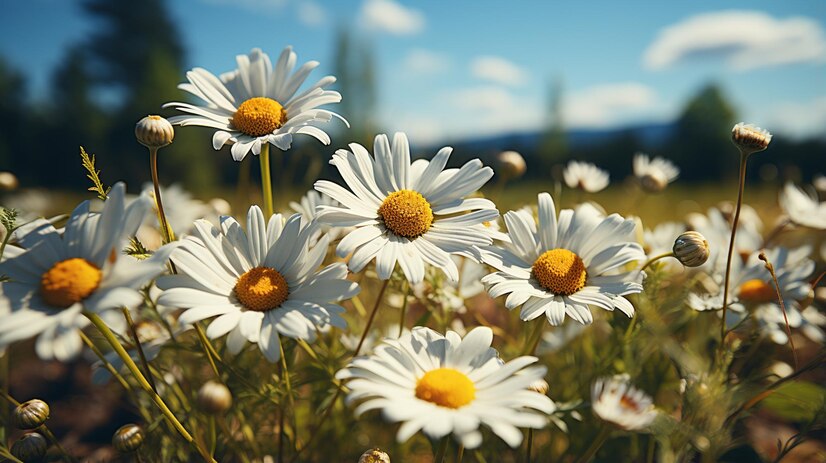Daises are one of the most recognizable flowers in the world, known for their simple yet charming appearance. With their white petals and bright yellow centers, these flowers symbolize purity, innocence, and new beginnings. In this article, we’ll explore the different types of daisies, their significance in various cultures, how to care for them, and their uses in gardening and floral arrangements.
The Anatomy of a Daisy
Daisies belong to the Asteraceae family, which includes a variety of flowering plants. Understanding the basic structure of a daisy can enhance your appreciation for this delightful flower.
Petals and Disc Flowers
A daisy typically has white or sometimes pink petals surrounding a central disc of tiny yellow flowers, known as disc florets. This unique structure is what makes daisies stand out among other flowers. The petals can be long and slender or broad and short, depending on the specific type of daisy.
Leaves and Stem
Daisy leaves are usually green, simple, and can be either basal or alternate along the stem. The stems can vary in height from a few inches to several feet, depending on the species. Most daisies thrive in well-drained soil and prefer full sunlight.
Types of Daisies
Daisies come in various species, each with unique characteristics. Here are some of the most popular types:
Common Daisy (Bellis perennis)
The common daisy is perhaps the most recognized variety. With its classic white petals and yellow center, it’s often found in gardens and meadows. It blooms in spring and can tolerate a range of soil conditions, making it a resilient choice for gardeners.
Shasta Daisy (Leucanthemum × superbum)
The Shasta daisy is a hybrid variety, known for its large, white flowers and robust growth. It typically blooms from late spring to early fall, adding a touch of brightness to any garden. This daisy thrives in well-drained soil and is often used in borders and as a cut flower.
African Daisy (Osteospermum)
Known for their vibrant colors, African daisies are native to South Africa. They come in various hues, including purple, pink, and white, making them a popular choice for adding color to garden beds. African daisies are drought-tolerant, making them suitable for warmer climates.
Gerbera Daisy (Gerbera jamesonii)
Gerbera daisies are known for their large, brightly colored blooms. They come in a wide range of colors, including pink, yellow, red, and orange. These daisies are often used in floral arrangements and are a favorite for special occasions due to their striking appearance.
Cultural Significance of Daisies
Daisies hold a special place in various cultures around the world, often symbolizing innocence and purity. Here’s a look at their significance in different contexts.
In Literature and Art
Daisies have been a source of inspiration for poets and artists alike. In literature, they are often used to represent innocence and the fleeting nature of beauty. Famous poets like William Wordsworth and Robert Frost have mentioned daisies in their works, capturing their essence in a few carefully chosen words.
In Folklore
In some cultures, daisies are believed to bring good luck and happiness. They are often associated with childhood and carefree days. Folklore also suggests that giving daisies as a gift can signify love and fidelity, making them a popular choice for weddings and romantic occasions.
In Medicine
Historically, daisies have been used in traditional medicine. Their leaves and flowers are believed to have anti-inflammatory properties and were once used to treat various ailments. While modern medicine has largely moved away from these practices, the daisy’s medicinal history adds to its allure.
Growing and Caring for Daisies
If you’re interested in cultivating daisies, understanding their care requirements is essential. Here’s a guide to ensure your daisies thrive.
Choosing the Right Location
Daisies prefer full sunlight, so choose a location in your garden that receives at least six hours of direct sunlight each day. They thrive in well-drained soil, so avoid areas where water tends to pool.
Planting Daisies
When planting daisies, it’s essential to space them adequately to allow for growth. Most varieties should be planted about 12 to 18 inches apart. Depending on the type of daisy, you may need to plant them in spring or fall.
Watering and Fertilizing
Daisies are relatively low-maintenance when it comes to watering. Water them regularly, but be cautious not to overwater, as this can lead to root rot. Fertilizing once or twice a year with a balanced fertilizer can promote healthy growth and vibrant blooms.
Pruning and Deadheading
To encourage continuous blooming, regularly deadhead spent flowers. This process involves removing faded blooms, which helps redirect the plant’s energy toward producing new flowers. Pruning can also help maintain the shape of the plant and promote healthier growth.
Daisies in Floral Arrangements
Daisies are a favorite in floral arrangements due to their cheerful appearance and versatility. Here are some tips for using daisies in your next arrangement.
Choosing the Right Daisies
When selecting daisies for an arrangement, consider the color scheme you want to achieve. Mix different varieties to create depth and interest. Gerbera daisies, for instance, can add a bold splash of color, while Shasta daisies provide a classic touch.
Combining with Other Flowers
Daisies pair well with various flowers, such as roses, lilies, and sunflowers. Combining different textures and colors can create a stunning bouquet. For a rustic look, consider using wildflowers alongside daisies to evoke a natural feel.
Care for Cut Daisies
To keep cut daisies fresh, place them in clean water immediately after cutting. Trim the stems at an angle and remove any leaves that will be submerged in water. Change the water every few days to prevent bacteria growth, ensuring your arrangement lasts longer.
Conclusion
Daisies are more than just beautiful flowers; they carry rich symbolism and cultural significance. From their variety of species to their role in gardening and floral arrangements, daisies offer something for everyone. Whether you choose to cultivate them in your garden or incorporate them into your floral designs, these charming blooms are sure to bring joy and beauty to your life.
FAQs
What are the different types of daisies?
There are several types of daisies, including the common daisy (Bellis perennis), Shasta daisy (Leucanthemum × superbum), African daisy (Osteospermum), and Gerbera daisy (Gerbera jamesonii).
How do I care for daisies in my garden?
Daisies prefer full sunlight and well-drained soil. Water them regularly but avoid overwatering. Deadheading spent flowers will encourage continuous blooming.
What do daisies symbolize?
Daisies symbolize purity, innocence, and new beginnings. They are often associated with childhood and happiness.
Can I grow daisies from seeds?
Yes, you can grow daisies from seeds. Plant them in spring or fall in well-drained soil, and ensure they receive plenty of sunlight.
Are daisies used in traditional medicine?
Historically, daisies have been used in traditional medicine for their anti-inflammatory properties. However, modern medicine has largely moved away from these practices.







